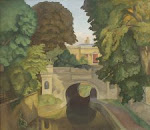"The River of Rivers in Connecticut" is the second to last poem in the collection. Taken together, I think that the two poems serve as a lovely and moving valedictory summing-up by Stevens.
Walter Goodin, "The River Beverley" (1938)
The River of Rivers in Connecticut
There is a great river this side of Stygia,
Before one comes to the first black cataracts
And trees that lack the intelligence of trees.
In that river, far this side of Stygia,
The mere flowing of the water is a gayety,
Flashing and flashing in the sun. On its banks,
No shadow walks. The river is fateful,
Like the last one. But there is no ferryman.
He could not bend against its propelling force.
It is not to be seen beneath the appearances
That tell of it. The steeple at Farmington
Stands glistening and Haddam shines and sways.
It is the third commonness with light and air,
A curriculum, a vigor, a local abstraction . . .
Call it, once more, a river, an unnamed flowing,
Space-filled, reflecting the seasons, the folk-lore
Of each of the senses; call it, again and again,
The river that flows nowhere, like a sea.
Wallace Stevens, Collected Poems (1954). Farmington and Haddam are towns in Connecticut. Stevens lived in Hartford, Connecticut.
I. E. Shaw, "Rhuddlan Castle, Denbighshire" (1988)
As for what the poem "means," I suggest that we think about the back-and-forth between the Imagination and Reality (the World) that is at the heart of Stevens's view of how we ought to live. We may also wish to consider something that Stevens wrote in "Sunday Morning": "Death is the mother of beauty." Make no mistake: we will all eventually end up in Stygia, accompanied by the ferryman. In the meantime, the river of rivers surrounds us, together with "the appearances that tell of it.'' It is up to us to make something out of the things around us that flash and flash in the sun, that glisten and shine and sway.
Trevor Makinson, "Maryhill Goods Yard"






No comments:
Post a Comment